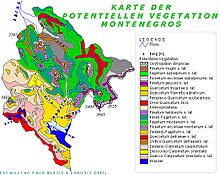Macedonian oak
| Macedonian oak | ||||||||||||
|---|---|---|---|---|---|---|---|---|---|---|---|---|

Macedonian oak |
||||||||||||
| Systematics | ||||||||||||
|
||||||||||||
| Scientific name | ||||||||||||
| Quercus trojana | ||||||||||||
| Webb |
The Quercus Trojana ( Quercus trojana ) is a plant from the genus of oak ( Quercus ) in the family of Fagaceae (Fagaceae).
description
Vegetative characteristics
The Macedonian oak is a small, semi-evergreen tree with heights of 10 to 20 meters. The leaves are relatively stiff, shiny and hairless. The leaf blade is narrow, 3 to 7 cm long and serrate with 8 to 14 pairs of teeth.
Generative characteristics
The fruit cups (cupula) are strikingly large with a diameter of 2 to 2.5 cm. The fruits ( acorns ) are 3 to 4.5 cm long.
The number of chromosomes is 2n = 24.
Occurrence
The Macedonian oak is native to Southeast Europe and Asia Minor ; its territory extends from southern Italy through the Balkans to western Turkey . In its range, the Macedonian oak is a paleo-endemic relic.
The Macedonian oak is mostly found in the submontane zone above the fully Mediterranean vegetation . The undergrowth consists mainly of deciduous elements, interspersed with only a few evergreen elements ( Phillyrea and Juniperus oxycedrus ). The Macedonian oak is more common on stone corridors and rock drifts in Herzegovina , Montenegro , Macedonia and Albania . Lujo Adamović gives a picture of the vegetation of the oak : an almost evergreen oak, the Macedonian oak (Quercus trojana) only inhabits the higher mountains around Dubrovnik (Ragusa) (such as Snijeznica, Rigja, Stedro, Bjelotina) and the neighboring Herzegovina. It is very reminiscent of Turkey oak, but has narrower and relatively longer, harder leaves. In Montenegro, and especially in Albania and the Puglia, this type of oak is more common.
Systematics
Within the genus of oaks ( Quercus ), this species belongs to the subgroup of Zerr oaks ( Cerris ) together with Turkey oak , cork oak and holm oak .
One can distinguish the following subspecies:
- Quercus trojana subsp. euboica (Papaioannou) KIChr. : This endemic occurs only in the northwestern part of the island of Evia .
- Quercus trojana subsp. trojana : It occurs in southeastern Italy, on the Balkan Peninsula and in western Turkey.
- Quercus trojana subsp. yaltirikii goal., Petrova & D.Tomasz. : It was first described in 2006 from Turkey.

Mixed forests with the Macedonian oak
The Macedonian oak dominates a remarkable phenomenon in the forest formation of Southeast Europe. Their plant community is called Quercetum trojanae Em 58 em. Horvat 59.
In addition to the Macedonian oak, other oaks ( Quercus pubescens , Quercus cerris ), ash trees ( Fraxinus ornus ) or the beech-like tree species oriental hornbeam ( Carpinus orientalis ) and European hop beech ( Ostrya carpinifolia ) set the tone. Also maples ( Acer obtusatum ) and haws ( Sorbus torminalis and Sorbus aria ) achieve high consistency. The common boxwood ( Buxus sempervirens ) often grows as a tree up to 3 m in height. Physiognomically , the society is therefore sometimes reminiscent of a pseudo macchia . The undergrowth is very diverse, especially on a lime base . Society is limited to shallow, warm and dry slopes.
Individual evidence
- ↑ Quercus trojana at Tropicos.org. In: IPCN Chromosome Reports . Missouri Botanical Garden, St. Louis
- ^ Adamović Lujo (1929): The flora of the Adriatic countries. Fischer, Jena.
- ↑ a b c d Rafaël Govaerts (ed.): Quercus - World Checklist of Selected Plant Families of the Royal Botanic Gardens, Kew. Last accessed on January 14, 2017.
- ^ Ivo Horvat, Vjekoslav Glavac & Heinz Ellenberg: Vegetation Southeast Europe. 1974
literature
- Lujo Adamovič: The flora of the Adriatic. Fischer, Jena 1929.
- Ivo Horvat , Vjekoslav Glavač & Heinz Ellenberg : Vegetation of Southeast Europe. Gustav Fischer, Stuttgart, 1974, ISBN 3-437-30168-3 .
- Jerzy Zieliński, Ana Petrova, Dominik Tomaszewski: Quercus trojana subsp. yaltirikii (Fagaceae), a new subspecies from southern Turkey. In: Willdenowia , Volume 36, Issue 2, 2006, pp. 845-849, doi : 10.3372 / wi.36.36214 .

